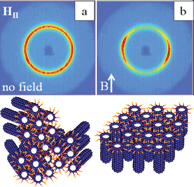Templating effects of lyotropic liquid crystals in the encapsulation of amyloid fibrils and their stimuli-responsive magnetic behavior
Abstract
The relationship between the symmetry of inverted lyotropic liquid crystals (

* Corresponding authors
a
ETH Zurich, Food & Soft Materials Science, Institute of Food, Nutrition & Health, Schmelzbergstrasse 9, LFO E23, Zürich, Switzerland
E-mail:
raffaele.mezzenga@agrl.ethz.ch
The relationship between the symmetry of inverted lyotropic liquid crystals (

 Please wait while we load your content...
Something went wrong. Try again?
Please wait while we load your content...
Something went wrong. Try again?
I. Amar-Yuli, J. Adamcik, C. Lara, S. Bolisetty, J. J. Vallooran and R. Mezzenga, Soft Matter, 2011, 7, 3348 DOI: 10.1039/C0SM01339K
To request permission to reproduce material from this article, please go to the Copyright Clearance Center request page.
If you are an author contributing to an RSC publication, you do not need to request permission provided correct acknowledgement is given.
If you are the author of this article, you do not need to request permission to reproduce figures and diagrams provided correct acknowledgement is given. If you want to reproduce the whole article in a third-party publication (excluding your thesis/dissertation for which permission is not required) please go to the Copyright Clearance Center request page.
Read more about how to correctly acknowledge RSC content.
 Fetching data from CrossRef.
Fetching data from CrossRef.
This may take some time to load.
Loading related content
